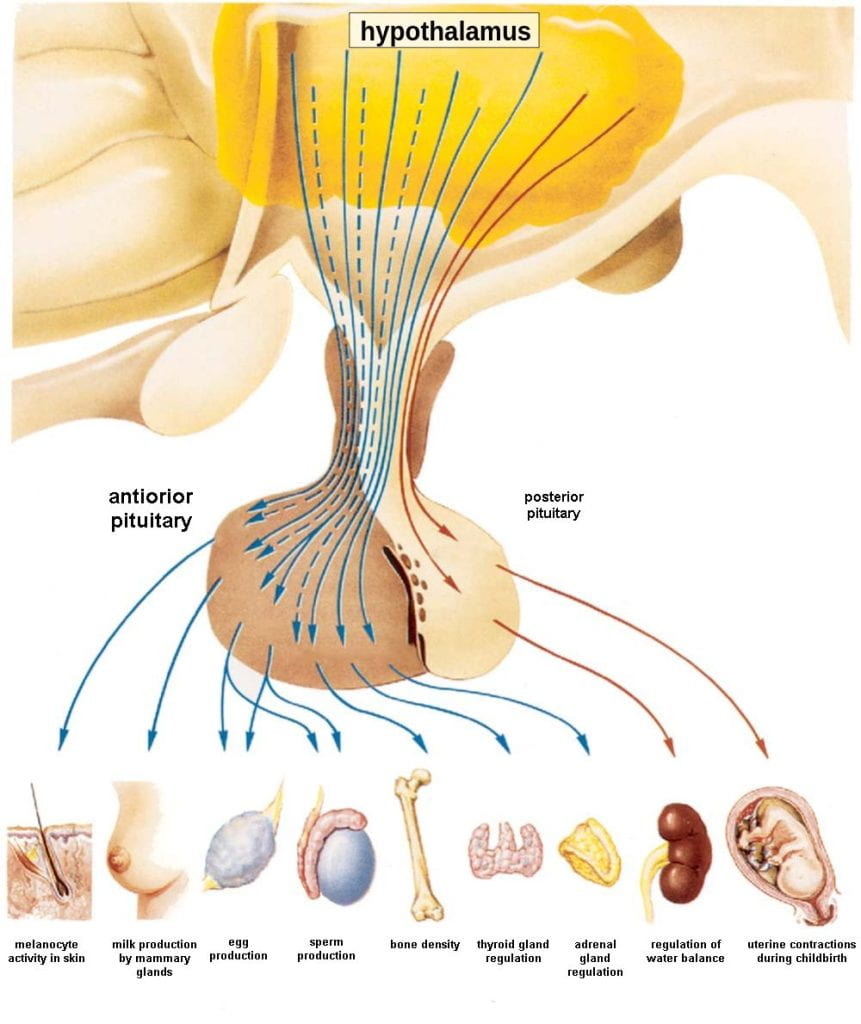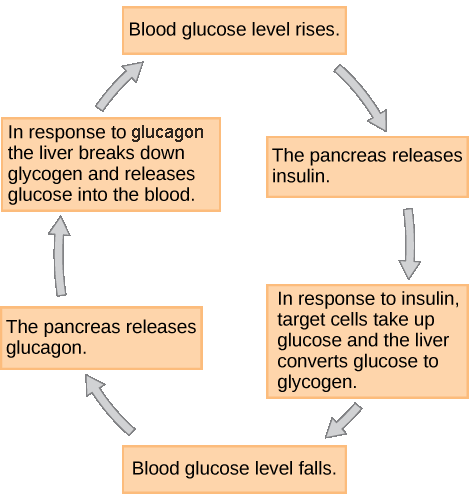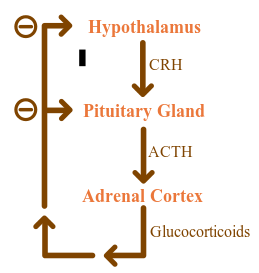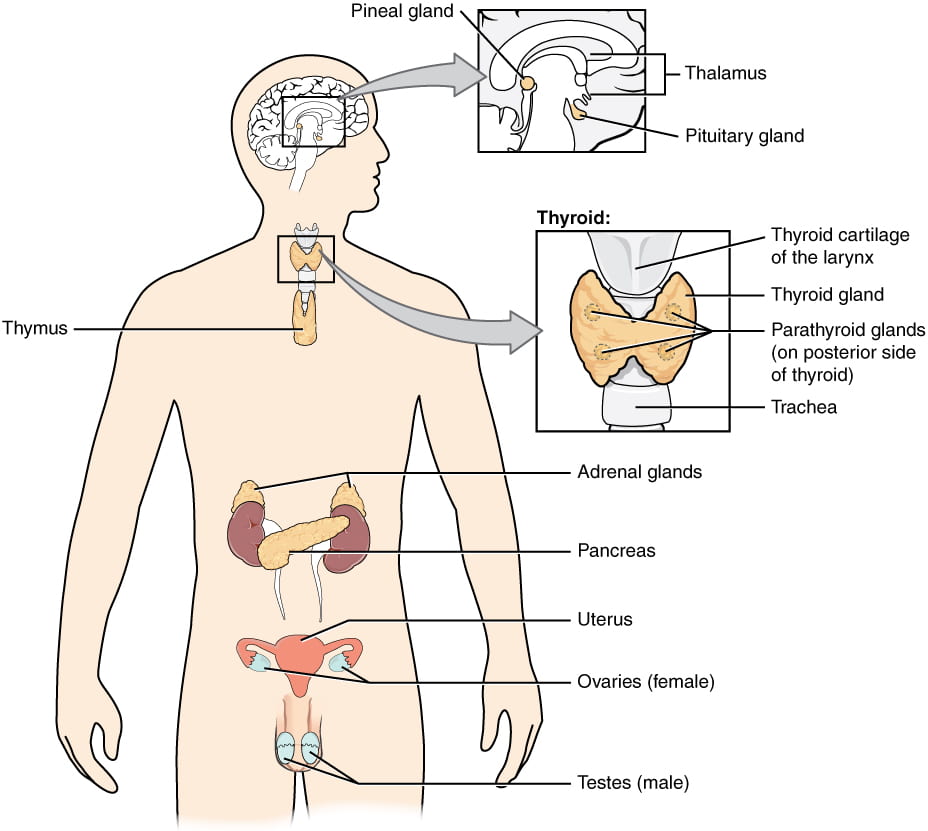Learning Objectives
- Identify the major glands and body structures involved in hormone synthesis in vertebrates, including the hypothalamus, the pituitary, the thyroid, the pancreas, the gonads, and the adrenal glands
- Recall the functions of selected hormones produced by select major glands, including the hypothalamus, the pituitary, the thyroid, the pancreas, the gonads, and the adrenal glands
- Describe the hormone pathway in given examples, including blood glucose, metamorphosis, and stress; and make predictions on how an animal would respond to given stimuli for each case
- Recognize instances of negative feedback loops, positive feedback loops, and crosstalk in the example hormone pathways
Vertebrate Endocrine Glands and Hormones
The information below was adapted from OpenStax Biology 37.5
Unlike plant hormones, animal hormones are often (though not always) produced in specialized hormone-synthesizing glands (shown below). The hormones are then secreted from the glands into the blood stream, where they are transported throughout the body. There are many glands and hormones in different animal species, and we will focus on just a small collection of them.
In vertebrates, glands and hormones they produce include (note that the following list is not complete):
- hypothalamus: located within the brain, the hypothalamus integrates the endocrine and nervous systems; it receives input from the body and other brain areas and initiates endocrine responses to environmental changes, synthesizes hormones which are stored in the posterior pituitary gland, and also synthesizes and secretes regulatory hormones that control the endocrine cells in the anterior pituitary gland
- pituitary gland: the body’s “master gland,” located at the base of the brain and attached to (and regulated by) the hypothalamus
- the anterior portion of the pituitary gland is regulated by releasing or release-inhibiting hormones produced by the hypothalamus
- the posterior pituitary receives signals via neurosecretory cells to release hormones produced by the hypothalamus
- thyroid gland: butterfly-shaped gland located in the neck; regulated by the hypothalamus-pituitary axis; produces hormones involved in regulating metabolism and growth including thyroxine (T4) and triiodothyronine (T3) which increase the basal metabolic rate, affect protein synthesis and other metabolic processes, help regulate long bone growth (synergy with growth hormone)
- adrenal glands: two glands, each located on one kidney; consist of adrenal cortex (outer layer) and adrenal medulla (inner layer), which each produce different sets of hormones:
- the adrenal cortex produces mineralocorticoids, such as aldosterone, which increases reabsorption of sodium by kidneys to regulate water balance; and glucocorticoids, such as cortisol, which is a long-term stress response hormones that increase blood glucose levels by stimulating synthesis of glucose and gluconeogenesis (converting a non-carbohydrate to glucose) by liver cells; promote the release of fatty acids from adipose tissue
- the adrenal medulla produces epinephrine (adrenaline) a short-term stress response (“fight-or-flight”) hormone that increases heart rate, breathing rate, cardiac muscle contractions, blood pressure, and blood glucose levels; accelerates the breakdown of glucose in skeletal muscles and stored fats in adipose tissue; the release of epinephrine is stimulated directly by neural impulses from the sympathetic nervous system
- pancreas: located between the stomach and the proximal portion of the small intestine; regulates blood glucose levels via two opposing hormones: insulin, which decreases blood glucose levels by promoting uptake of glucose by liver and muscle cells and conversion to glycogen (a sugar storage molecule) and glucagon, which increases blood glucose levels by promoting breakdown of glycogen and release of glucose from the liver and muscle
- gonads (ovaries and testes): produce sex steroid hormones that promote development of secondary sex characteristics and regulation of gonad function
The processes and organs regulated by the pituitary gland are summarized here:

This video provides a nice overview of the glands and hormones of the vertebrate endocrine system:
Hormonal Regulation of Body Processes in Animals
The information below was adapted from OpenStax Biology 37.3
Hormones have a wide range of effects and modulate many different body processes. The key regulatory processes that will be examined here are those affecting blood glucose, metamorphosis, and stress. We will primarily focus on these processes in vertebrates, but will also consider invertebrates in some cases.
Blood Glucose
Glucose is the primary energy source for most animal cells, and it is distributed throughout the body via the blood stream. The ideal, or target, blood glucose concentration in humans is about 90 mg/100 mL of blood, which is about 1 tsp of glucose per 6 quarts of blood. After a meal, carbohydrates are broken down during digestion and absorbed into the blood stream. The amount present following a meal is typically more than what the body needs at that moment, and so the extra glucose must be removed and stored for later use. The opposite phenomenon occurs following a period of fasting. Blood glucose levels are regulated by two hormones produced by the pancreas:
Insulin is produced by the beta cells of the pancreas, which release insulin when blood glucose levels rise above normal levels (for example, after a meal is consumed). Insulin lowers blood glucose levels through several processes:
- enhances the rate of glucose uptake and utilization by target cells, which use glucose for ATP production
- stimulates the liver to convert glucose to glycogen, which is then stored by cells for later use
- increases glucose transport into certain cells, such as muscle cells and the liver
- stimulates the conversion of glucose to fat in adipocytes and the synthesis of proteins.
These actions together cause cause blood glucose concentrations to fall, called a hypoglycemic ‘low sugar’ effect, which inhibits further insulin release from beta cells through a negative feedback loop.
When blood glucose levels decline below normal levels, for example between meals or when glucose is utilized rapidly during exercise, the hormone glucagon is released from the alpha cells of the pancreas. Glucagon raises blood glucose levels, causing a hyperglycemic effect through several mechanisms:
- stimulates the breakdown and release of glucose from glycogen in liver cells
- stimulates absorption of amino acids from the blood by the liver, which then converts them to glucose
- stimulates adipose cells to release fatty acids into the blood
Glucose can then be utilized as energy by muscle cells and released into circulation by the liver cells. These actions mediated by glucagon result in an increase in blood glucose levels to normal homeostatic levels. Rising blood glucose levels inhibit further glucagon release by the pancreas via a negative feedback mechanism. In this way, insulin and glucagon work together to maintain homeostatic glucose levels, as shown in below.

Uncontrolled blood glucose levels can lead to different types of serious medical conditions:
- Impaired insulin function can lead to a condition called diabetes mellitus. Diabetes mellitus can be caused by low levels of insulin production by the beta cells of the pancreas, or by reduced sensitivity of tissue cells to insulin. Either of these situations prevents glucose from being absorbed by cells, causing high levels of blood glucose, or hyperglycemia (high sugar). Over time, high blood glucose levels can cause nerve damage to the eyes and peripheral body tissues, as well as damage to the kidneys and cardiovascular system.
- Oversecretion of insulin can cause hypoglycemia, low blood glucose levels, which causes insufficient glucose availability to cells, often leading to muscle weakness, and can sometimes cause unconsciousness or death if left untreated.
This animation describes diabetes and the roles of insulin and the pancreas in blood glucose regulation:
Growth and Metamorphosis
The thyroid gland in vertebrates controls growth and metabolism through the hormones thyroxine (T4) and triiodothyronine (T3); in vertebrate species like amphibians that undergo metamorphosis, surges of T3 are initiate the development of new structures, reorganize internal organ systems, and control other processes that occur during metamorphosis.
In insects, metamorphosis is controlled by a set of hormones that determine whether the animal grows into the next larval stage or changes into an adult as it gets larger:
- The corpus allatum, an endocrine gland in the brain, secretes a hormone called juvenile hormone during all larval stages, which maintains the larval status of the animal.
- As the larvae grows, another endocrine gland in the brain releases prothoracicotropic hormone, which signals to the prothoracic gland to release the hormone ecdysone.
- Ecdysone promotes either molting (shedding the exoskeleton) or metamorphosis, depending on the level of juvenile hormone.
- Ecdysone in combination with high juvenile hormone results in molting into the next larval stage; ecdysone in combination with low juvenile hormone results in metamorphosis into an adult. (Notice the difference in outcome in response to ecdysone based on whether juvenile hormone is present; this phenomenon is an example of crosstalk.)
Stress: Short vs Long Term Responses
One of the main functions of endocrine hormones is to ensure the body’s internal environment remains stable (homeostasis). Stressors are stimuli that disrupt homeostasis. Some stressors require immediate attention and activate the short term, “fight-or-flight” stress response, which stimulates an increase in energy levels through increased blood glucose levels. This prepares the body for physical activity that may be required to respond to stress: to fight for survival, flee from danger, or freeze. The fight-or-flight response exists in some form in all vertebrates.
In contrast, some stresses, such as illness or injury, can last for a long time. Glycogen reserves, which provide energy in the short-term response to stress, are exhausted after several hours and cannot meet long-term energy needs. If glycogen reserves were the only energy source available, neural functioning could not be maintained once the reserves became depleted due to the nervous system’s high requirement for glucose. In this situation, the body has evolved a response to counter long-term stress through the actions of the glucocorticoids, which ensure that long-term energy requirements can be met. The glucocorticoids mobilize lipid and protein reserves, stimulate gluconeogenesis, conserve glucose for use by neural tissue, and stimulate the conservation of salts and water.
The sympathetic nervous system regulates the stress response via the hypothalamus. Stressful stimuli cause the hypothalamus to signal the adrenal medulla (which mediates short-term stress responses) via nerve impulses, and the adrenal cortex, which mediates long-term stress responses, via the hormone adrenocorticotropic hormone (ACTH), which is produced by the anterior pituitary.
Short-term Stress Response
When presented with a stressful situation, the body responds by calling for the release of hormones that provide a burst of energy. The hormones epinephrine (also known as adrenaline) and norepinephrine (also known as noradrenaline) are released by the adrenal medulla. These two hormones prepare the body for a burst of energy in the following ways:
- cause glycogen to be broken down into glucose and released from liver and muscle cells
- increase blood pressure
- increase breathing rate
- increase metabolic rate
- change blood flow patterns, leading to increased blood flow to skeletal muscles, heart, and brain; and decreased blood flow to digestive system, skin, and kidneys
Watch this Discovery Channel animation describing the flight-or-flight response:
Long-term Stress Response
Long-term stress response differs substantially from short-term stress response. The body cannot sustain the bursts of energy mediated by epinephrine and norepinephrine for long times. Instead, other hormones come into play. In a long-term stress response, the hypothalamus triggers the release of ACTH from the anterior pituitary gland. The adrenal cortex is stimulated by ACTH to release steroid hormones called corticosteroids. The two main corticosteroids are glucocorticoids such as cortisol, and mineralocorticoids such as aldosterone. These hormones mediate the long-term stress response in the following ways:
- glucocorticoids:
- promote breakdown of fat into fatty acids in the adipose tissue and release into bloodstream for ATP production
- stimulate glucose synthesis from fats and proteins to increase blood glucose levels
- inhibit immune function to conserve energy
- mineralocorticoids:
- promote retention of sodium ions and water by kidneys
- increase blood pressure and volume (via sodium/water retention)
Corticosteroids are under control of negative regulation feedback loop (illustrated below), which can become misregulated in cases of chronic long-term stress. (Note that a negative feedback loop is not the same thing as negative regulation.)

In contrast to chronic long-term stress, the video below discusses some of the circumstances where stress can be good for you:


